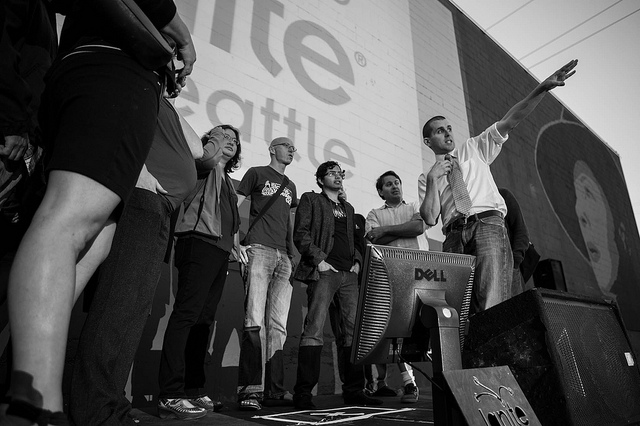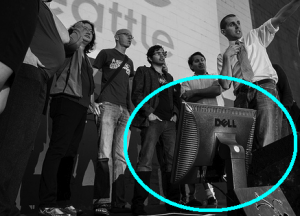How to be a great host (at Ignite)
Ignite Seattle, an evening of fast presentations, runs like clockwork. We think of the evening as a show, and each of the 16 speakers we have at each events are the stars. We do all that we can to set the stage, the audience and the format to make it as easy as possible for them to do a great job. One key role is the host or emcee (MC). They are the first and last person on stage, tying all the pieces together for the audience. I’ve hosted many Ignite events and here’s my advice on how to do it well.

Before the event
- Go watch someone else host. You will watch events differently if you are deliberately paying attention to the host. There are many little things good ones do that normally you won’t notice. Go watch your local Ignite and pay attention: what seems to help the audience and speakers? What doesn’t? How are they helping the audience stay engaged?
- Point speakers at good advice for how to prepare. The speakers are the talent – you’re a fool if you don’t do everything you can to help them prepare well and to be comfortable and relaxed when they arrive. There are many good posts and books about public speaking: find advice you like on common mistakes and how to avoid them and share it. Here is the checklist I give to speakers, as well as a list of common mistakes I see speakers make. Ignite Seattle now even does live coaching with speakers a week before the event where we give them feedback on practice runs.
- Get a slide wrangler. Since the event is a series of talks, you need to have all the slides on one machine, in one deck, with one person who runs them during the show. This eliminates the need to switch slide decks, or computers, which kills audience energy and wastes time. If you have 10 speakers, that’s 10 transitions, and even if each one takes 60 seconds, that’s two Ignite talks worth of dead time.
- Confirm the speaker order with the Slide Wrangler. Since the slide order wins any debates with you as the MC, you don’t want a speaker up there when someone else’s slides are showing.
- Know the seating plan. Speakers need to be lined up, in order, near the stage. This speeds transitions between talks. Make sure whoever controls the layout of the room is reserving enough chairs for all the speakers.
At the event
- Get there early and say HI to all volunteers. Often Ignite’s have volunteers who help run the event. Be friendly to them. If anything goes wrong they’re the ones who will know about it first and respond, and you want to know who and where they are. As the host, you will be the person who has to explain, or respond to, anything that goes wrong in front of the crowd.
- Speakers are depending on you. Most of them will be nervous. They need someone to tell them where to be and what to do. That is your job as host. You are not just host for the audience, you are also the host for the performers. Make sure they have what they need. A nice touch is to have a box of bottled water in the speaker waiting area – it’s a common pre-speaking request.
- 30 minutes before start, assemble all the speakers. Use the PA to ask all speakers to come to the stage. Introduce yourself and have a short meeting that covers: a) the order they’ll be speaking b) where they are supposed to sit c) letting them walk on stage to get their bodies comfortable with what it feels like d) a reminder of how awesome they are and how supportive the audience will be (lie if necessary).
- Make sure you ask speakers how to pronounce their names. Have a pad of paper listing the speaker order, and when you ask them how to pronounce, write it down. You won’t remember otherwise. Plan to take that paper with you up on stage.
- Make sure to give them a tour of the stage. By letting them walk on the stage you calm their nerves. Their bodies get to see what it will actually be like when they speak. if you don’t do this, they have to deal with the sensory surprise of what the lights, audience, etc. feel like. You don’t want to surprise your speakers.
- If there are special instructions for where to stand, tell them. If the event is videotaped, wise videographers put a X, or other marker on the stage to let speakers know where to be. Speakers won’t know what it’s for if you don’t tell them.
- If there is a confidence monitor for them to use, tell them what it is. It helps speakers if they can see their own slides as they are talking. Most speakers will never have seen a confidence monitor before, so you’ll need to explain that it will indicate the current slide the audience sees, but will be too small to read (see image).
During the event
- Have intro slides that explain the format. Many people will never have been to an Ignite before. Have an opening talk (preferably done as an ignite talk) that covers the basics. Here’s the slide deck I used at Seattle Ignite #17.
- Your job is similiar to being a game show host. Your primary function is to add positive consistency to the event. You don’t need to do much, other than be happy, energetic, and enthusiastic for the speakers.
- Make the transitions as smooth as possible. The reason for having speakers sit in order, near the stage, is to accelerate the transitions. Ask for a round of applause before, and after, each speaker. The audience will almost always oblige, and the speakers will perform better.
- Be prepared to introduce people’s names and topics. On your host sheet that you bring on stage, list their name, pronunciation guide, and their topic. You should be able to say something brief and positive about each speaker. Have some variety of intros prepared as they can get repetitive: “I’m so excited”, “This should be a great talk on”, “this might be my favorite”, etc.
- Milk the audience for applause. It’s fair for each speaker to get some applause as they take the stage and when they leave. Some audiences are lazy – it’s up to you to remind them.
- If there is a break, let people know how long. It’s wise to break the event into two parts, with half the speakers in each part. If you do break, remind people how much time they have, where the restrooms or snacks are, etc. If you break, you should repeat the call for speakers 15 minutes before the 2nd half, to make sure they are all there and seated in the right place.
After the event
- Thank your speakers. Ignite events often create community and you can help this by emailing your speakers to thank them for participating. Remind them if any videos or slides will be posted online so they can help spread the word. Create a ignite-speakers mailing list, so alumni can stay in touch. This can be helpful in finding future speakers or doing other events.
- Have a debrief dinner with the other volunteers. Get together a few days later to review what went well and what could have gone better. Use this info in planning your next ignite.
- Come back here and add your own tips. What other tricks do you learn that other hosts should know? Come back here and leave a comment.
(Photo by Shawn Murphy)


I’ve found it interesting that Portland goes host-less. There’s a host to quickly kick things off but then the slideshows run uninterrupted, with a 15 second transition slide between each show.
Sadly I’ve never made it to Portland Ignite, but I’ve heard great things.
I’m sure there are many different ways hosting is done – I hope this post will help people share what they’ve tried and why.
This blog really helped me a lot to become a better host. I believe that I’m not barking the wrong tree.
This blog is very helpful for those who aspire to become host or anchor.
I would like to thank the blog owner to share such a wonderful knowledge.
Am planning to have my own TV talk show and i still need your help. Just to tell me
1)what to do before i start my show,
2)in the middle of the show
3)at the end of the show
It’s interesting to learn that when it comes to hosting a debate event that there are some things that need to be done beforehand to help make the whole thing turn out. I like how you mentioned that the host might want to make sure that they get a side wrangler so that when it comes to the slideshow only one person has everything under control so there isn’t any wait time. This makes sense so that the event doesn’t go longer than need be and the spectators won’t get bored being there.
Very helpful. I am doing as much research as possible for my new hostessing and MC job and this was definitely informative
It’s really nice to go through this blog, you’re awesomely great Scott berkun